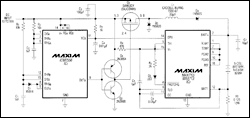
An efficient fast-charge circuit (Figure 1) features a controller chip that normally implements linear regulaTIon with an external pnp transistor. This circuit, however, subsTItutes a p-channel MOSFET for the pnp and implements switch-mode PWM regulaTIon with the help of an inductor, two Schottky diodes, and a 60¢ dual timer (IC1). The timer's "B" side is configured as a one-shot that receives nominal 70kHz triggers from the free-running "A" side.

More Detailed Image (PDF, 231kB)
Figure 1. This two-IC circuit provides efficient charging at a two-ampere rate for series connections of NiCd or NiMH cells.
During a charge, IC2 monitors the slope of battery voltage vs. time. The MAX712 (for nickel-metal-hydride batteries) terminates charging when the slope reaches zero; the MAX713 (for NiCD batteries) terminates charging when the slope goes negative. As a backup probision, you can program an internal timer to terminate charge after 1/4, 1/2, 1, or 2 hours (times a multiple of 1.5X or 2X).
As a further backup, comparator circuits in IC2 monitor the battery temperature, preventing charging if the battery is too cold and terminating charging if the battery becomes too hot. In every case, the IC applies a trickle charge of C/16 (125mA in Figure 1) after termination of the fast charge.
You can program IC2 for charging 1 to 16 cells in series. The device simultaneously monitors and regulates battery voltage and charge current (via current-sense resistor R6), and issues drive signals at the open-drain output DVR. These signals implement pulse-width modulation by altering the duty cycle of Q1's gate drive.
Constructed with narrow-SO surface-mount components, the circuit fits easily into notebook computers and other portable equipment. When delivering two amperes it can charge a stack of six sub-C cells in less than one hour. The efficiency is 89% for VIN = 12V and VOUT = 9V, and the power dissipation is virtually constant at 2.3W for VIN = 11 to 16V and VOUT = 3 to 9V (VIN must exceed the maximum battery voltage by at least 1V). Heat sinks are unnecessary because no component dissipates more than 0.5W.
欢迎分享,转载请注明来源:内存溢出

 微信扫一扫
微信扫一扫
 支付宝扫一扫
支付宝扫一扫
评论列表(0条)